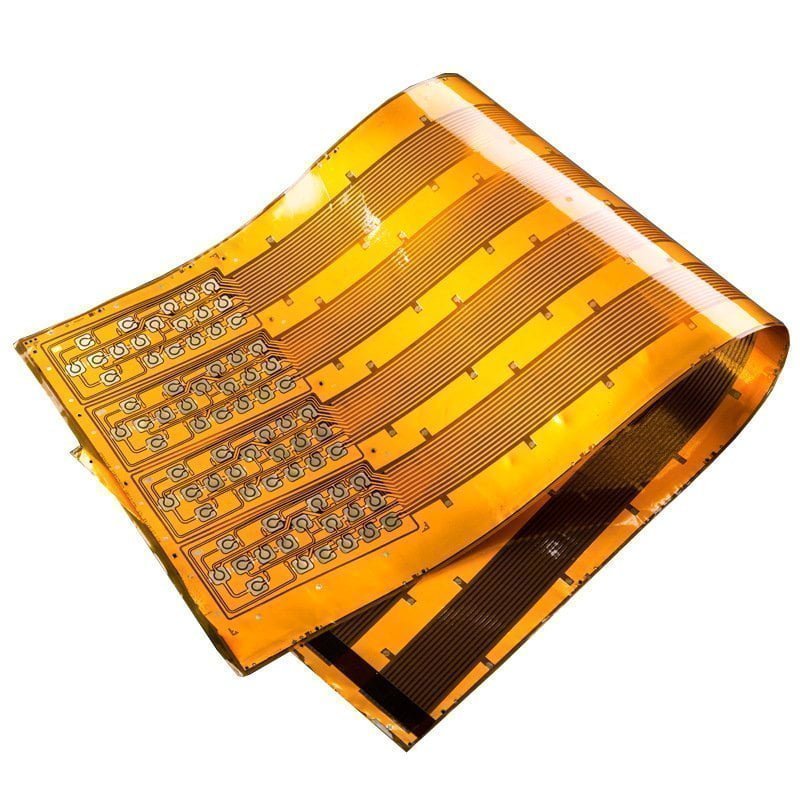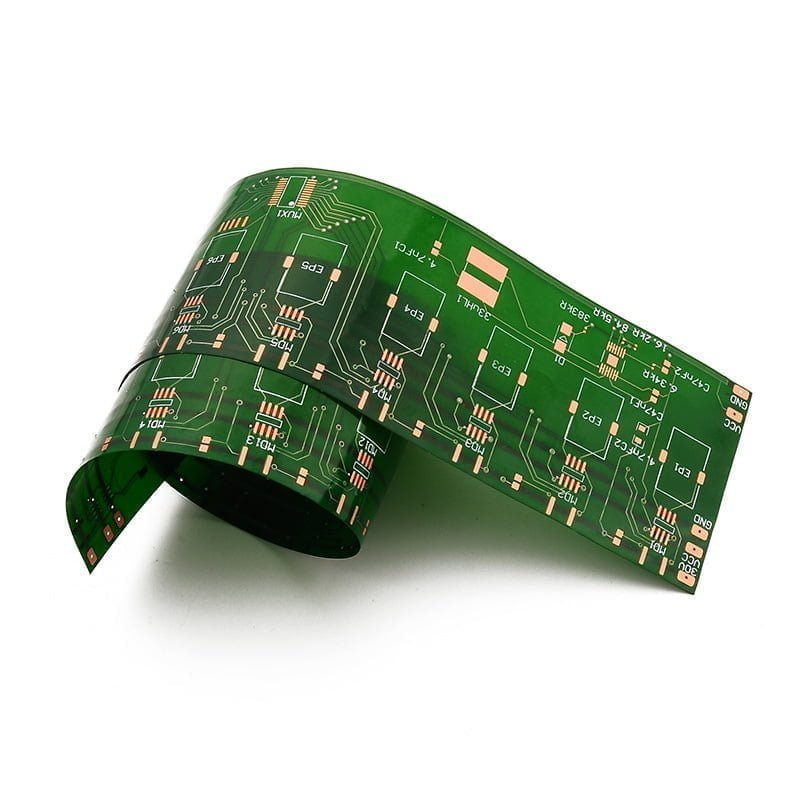There are several materials used to make circuit boards. Each has its benefits and drawbacks, but none are perfect for every application. Polyimide rigid PCBs, for example, have a wide range of applications in everything from aerospace to automotive. They’re strong enough to withstand impacts that would shatter other types of circuit boards, but they’re also flexible enough to be bent without cracking or breaking.
Let’s take a look at why you might choose rigid polyimide PCBs over alternatives like glass epoxy boards, FR-4 PCBs, and PEN-epoxy hybrid circuit boards.
What is Polyimide Rigid PCB?
Polyimide rigid PCBs are made from polyimide (PI) material. The PI is a high-performance polymer that’s both flexible and strong. It can withstand impacts and high temperatures without losing its electrical properties. In fact, it’s the most electrically durable rigid-form PCB on the market.

Advantages of Rigid Polyimide PCB
It’s important to know when to use polyimide printed circuit boards and when not to, since they are only used in certain situations. Polyimide PCBs can provide one or more of the following benefits:
1. High resistance to chemicals
It is resistant to most acids, bases, and solvents. If a chemical should happen to penetrate the pcb board, it will not cause any damage to the board. It is also very resistant to UV rays, so it can be used outdoors without any worry of damage from the UV rays.
2. High strength and rigidity
Unfilled polyimide has a tensile strength of more than 100 MPa, with a film stiffness of over 170 MPa (Kapton). The impact strength of the thermoplastic polyimide (TPI) ranges from 261 joules per square metre to 400 MPa (Upilex S). As an engineering material, the elastic modulus is typically 3-4 GPa, with fibre stiffness of 200 GPa. The biphenyl form of polyimide (Upilex S) has an elastic modulus of 400 MPa. According to theoretical analysis, fibres synthesized from pyromellitic dianhydride and p-phenylenediamine have a strength of 500 GPa, only second to carbon fibre.
3. Excellent thermal stability
One of the benefits of polyimide rigid pcb is that it has a high melting point, which makes it resistant to high temperatures. It is often used in areas where other pcb boards cannot withstand the heat. It is also flame retardant, which makes it a safe option for sensitive environments like factories and laboratories.
4. Static-resistant
Static electricity is a significant problem for engineers and technicians that work with sensitive equipment. Sensors and other equipment can be damaged by static electricity. Static electricity can also damage sensitive electronic components on pcb boards. Polyimide boards are a good option for all environments thanks to their static-resistant properties.
5. Low dielectric loss
Polyimide has excellent dielectric properties, with a dielectric constant of about 3.4 and a dielectric constant of about 2.5 after fluorine or air nanometer-sized dispersion. It has a dielectric loss of 10-3, a dielectric strength of 100-300 kV/m, and a volume resistance of 1017 Ω·cm. These characteristics maintain high performance over a wide temperature and frequency range.
6. Safe and non-toxic
The polyimide rigid pcb is safe to use and does not emit any harmful fumes or toxins. In fact, polyimide pcb is often used in hospital device as it is a non-toxic and non-irritating substance.
Types of Polyimide PCB
There are three types of rigid polyimide PCBs, each with its own set of properties designed to meet the needs of specific applications. As with other circuit board materials, the type of polyimide PCB you use will depend on the application.
Pure Polyimide PCBs
Pure polyimide PCBs are among the most simple and don’t possess brominated flame retardants. In contrast to most materials, pure polyimides are positively described as lacking flame retardants. Because it’s so tough, pure polyimide is extremely flexible and can be used in a variety of electrical and communicative equipment.
3rd Generation Polyimide PCBs
Pure polyimides have been supplanted by 3rd generation polyimides. Additional additives improve its fire resistance. This is due to its flammability resistance, which makes accidental electrical fires less likely. Thermal stability, on the other hand, is a potential issue with the 3rd generation polyimide, which is easier to produce than pure polyamides. The result is a higher manufacturing rate.
Filled Polyimide PCBs
A polyimide of this sort is comparable to multilayer PCBs in that it comprises several filler materials. The extra filler reduces resin shrinkage. because many printed circuit boards crack down or become weak as a result of resin shrinkage, the shrinkage resistance is crucial. Polyimide filled with fillers also benefits from long-term reliability.
Low-Flow Polyimide PCBs
Low-flow polyimides are not as flexible as standard PCBs. They are often referred to as rigid polyimide PCBs because of this restriction. When challenging conditions cause regular flexible PCBs to collapse, low-flow polyimides are available to get the job done.
When to Use Polyimide Rigid PCB
Polyimide PCBs are used in a wide range of applications, including industrial automation, transportation, healthcare equipment, instrumentation and electronics.
● Electrical transformers and capacitors
● Semiconductor devices and circuit boards
● Motors and generators
● Electronic ballasts for fluorescent lighting
● Aerospace and military
Polyimide PCB VS FR4 PCB
While both rigid polyimide and FR-4 PCBs are made from copper on the inside, their external layers differ greatly. FR-4 PCBs have a polyester/paper laminate on the outside, while polyimide PCBs have a polyimide coating. Rigid polyimide boards are considerably more durable than FR-4 boards. They’re able to withstand impacts, chemicals, and high temperatures that FR-4s can’t. However, FR-4 boards are more flexible than rigid polyimide boards, making them a better choice for applications that require frequent bending.

| Characteristic | FR4 PCB | Polyimide PCB |
| Tensile Strength | 70MPa | 170~400MPa |
| Operating Range | -50~110°C | -200~300°C |
| thermal cycling | good | better |
| elastic modulus | >2.4Gpa | 3-4GPa |
| specific gravity | 1.70-1.90g/cm³ | 1.60g/cm³ |
| relative permittivity | 5.5 | 2.5~3.4 |
Reverse Engineering of Polyimide PCB
You can reverse engineer a polyimide rigid PCB to create a design that’s compatible with the original circuit board. This is a great option if you need to produce a large number of boards without investing in new design or manufacturing processes.
To reverse engineer a polyimide PCB, you’ll first need to acquire the board. If you don’t have access to a sample, you can often find boards for sale online. Next, remove the components and clean the circuit board. Finally, use imaging software to create a digital image of the board. You can then use that image to create a new design.
As an alternative solution, you can also choose our reverse engineering service for pcb. We have more than 10 years of experience and 1000+ sucessful cases in this filed, so you can get what you need.
Conclusion
Rigid polyimide boards are the strongest type of circuit board available. They can withstand impacts that would break other boards, and they can withstand high temperatures that would melt FR-4 boards. However, they’re also more expensive and less flexible than other types of rigid PCBs. If you need a board that’s extremely durable, rigid polyimide is the right choice. But if flexibility is important, you’ll want to choose FR-4 boards.








